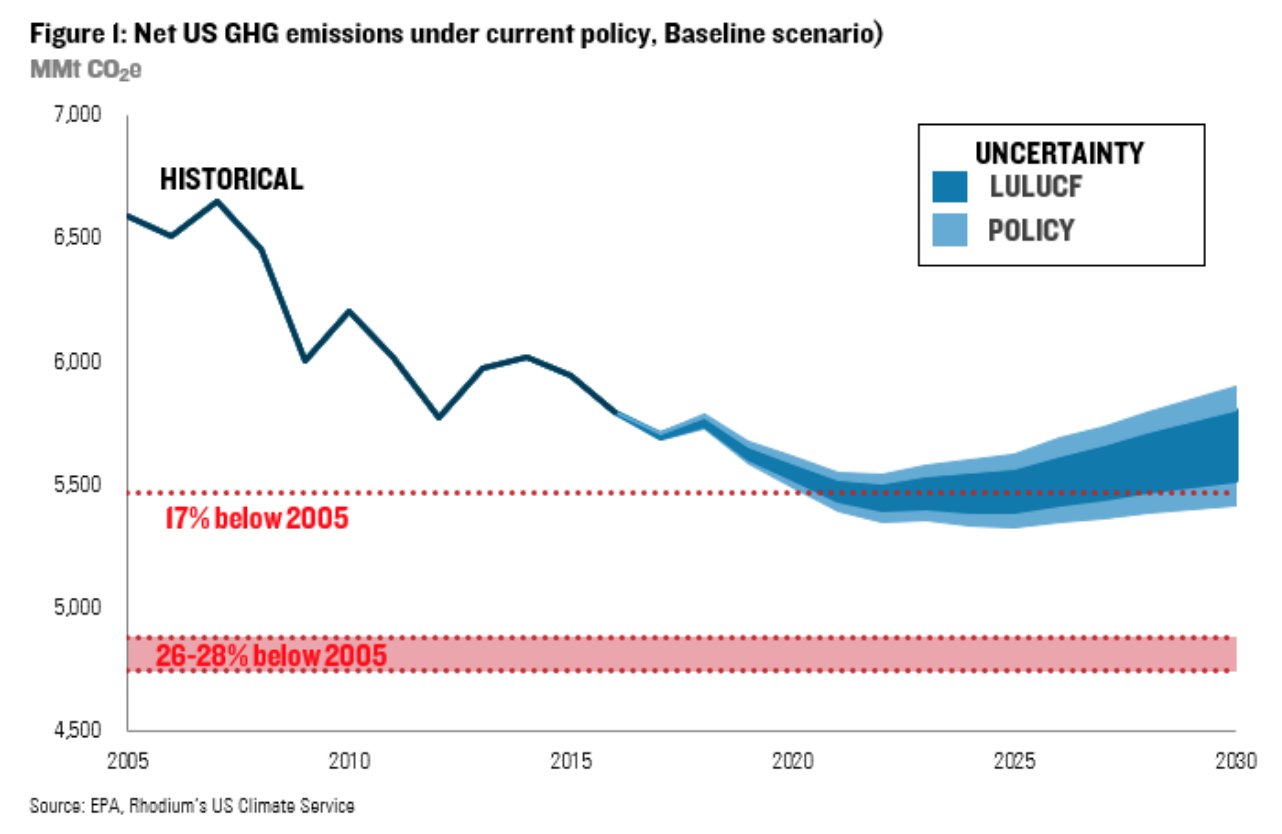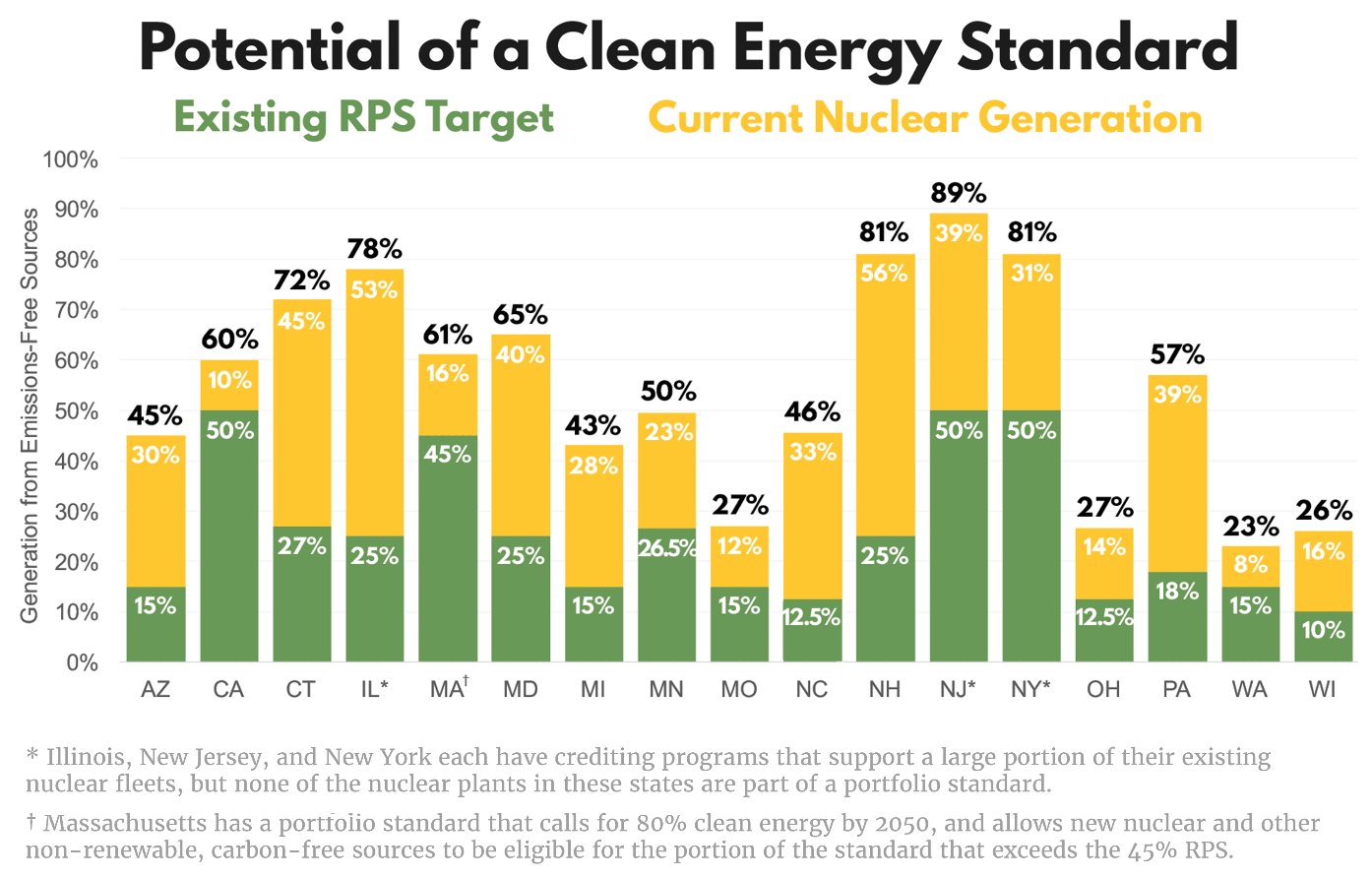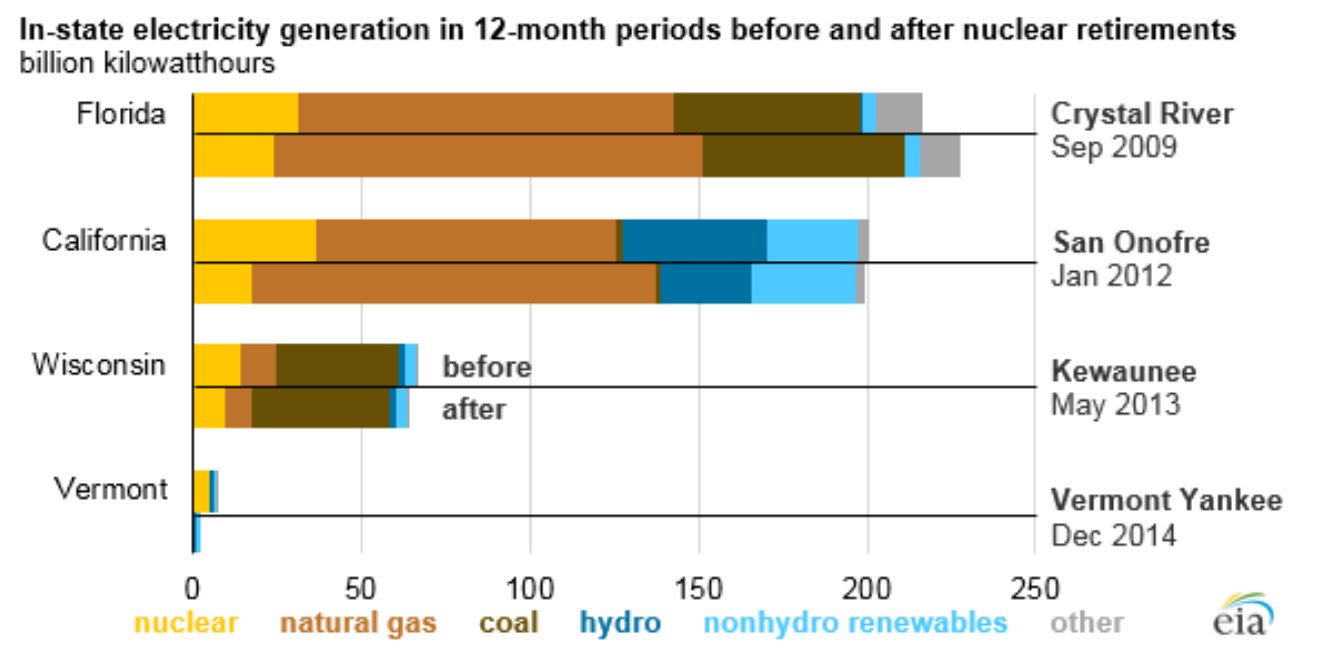The United States has a carbon emissions problem.
A recent analysis by Rhodium Group found that current federal and state policies put the U.S. on track for a 12 to 20 percent reduction in 2005 greenhouse gas emissions by 2025, which is well below the country's Paris Agreement commitment of a 26-28 percent reduction. After 2025, progress could stall and even reverse.
Transportation remains America’s largest source of emissions through most of Rhodium Group’s outlook, but it’s not the only issue. Today, carbon is being rapidly pushed out of the electricity sector with cheap natural gas and renewables rapidly replacing coal. But those same market forces are also pushing zero-emitting nuclear plants into retirement, which could trigger a rebound in power-sector emissions post-2025.
According to Rhodium Group’s Trevor Houser, state-level "clean energy standards" are one important remedy. A new report by Third Way Energy and The Breakthrough Institute (BTI) — the focus of this week’s State Bulletin — makes the case for why states should adopt a portfolio standard for a broader set of resources.

The Third Way/BTI report argues that state renewable portfolio standards are a step in the right direction, but that states could cut emissions more affordably, rapidly and reliably if their policies extended to a wider set of carbon-free resources.
“A state could create a clean energy standard (CES) instead of a renewable portfolio standard, which would take advantage of renewables as well as existing and new nuclear, carbon capture and storage, waste-to-energy, and other technologies in its effort to eliminate carbon from the power sector,” the authors argue. “By putting additional clean energy options on the table, most states would be able to set much more ambitious targets for emissions reduction — often doubling their current RPS levels — and some unexpected states could rapidly become new leaders in the fight against climate change.”
Large amounts of nuclear power are generated in 17 of the states with an RPS, according to the report. Yet none of them explicitly factor nuclear generation into their grid mandates (New York's, Illinois' and New Jersey’s zero-emissions credit programs, detailed below, don’t count in this assessment).

Third Way and Breakthrough point out that the retirement of nuclear power plants has generally led to an increase in the use of fossil fuels, despite strong growth in renewables.
Even under optimistic deployment scenarios, renewables alone are unlikely to meet U.S. clean energy and emissions goals, according to the report. Unless states take further action, the Energy Information Administration projects that just 41 percent of U.S. electricity will come from clean energy sources in 2050, up only slightly from the 37.5 percent today.

A renewable portfolio standard requires utilities and other load-serving entities to sell a certain percentage of their electricity from a specific type of resource by a certain year, typically renewable electricity sources like solar, wind, hydropower and geothermal. Today, 27 states and the District of Columbia have a binding RPS in place, with an average requirement of 26 percent renewables and an average target year of 2022.
More than 60 percent of renewable energy deployment since 2000 has occurred in states with an RPS in place, according to researchers at the Lawrence Berkeley National Laboratory. In a 2016 study, Berkeley Lab researchers also found that public health and emissions benefits far outweigh the costs of compliance.
The problem Third Way and BTI highlight is that current RPS targets aren’t set remotely high enough achieve full decarbonization.

Opting instead for a “technology-inclusive” clean energy standards “would allow states to set more ambitious targets for carbon-free power, create a backstop against any future growth of dirty fossil fuels, and expand political support to achieve emissions goals more rapidly,” the authors write.
A broader CES would also send positive market signals for emerging carbon-free technologies, including carbon capture, waste-to-energy plants and both new and existing nuclear power plants
The CES catch
The CES proposal may sound appealing and relatively easy to implement. But it is a highly controversial concept in today’s energy policy landscape — particularly the nuclear power piece of it.
For one thing, building new nuclear power plants has proven to be extremely expensive and time-intensive. As a result, several projects have recently been abandoned. Today, there is just one new nuclear power plant under construction in the U.S.
Maintaining existing nuclear plants is also a subject of intense debate. Five nuclear power plants have closed since 2013, and more than half of the remaining fleet is facing financial challenges. This has led some states to pass policies that prop up their existing nuclear plants, which has triggered blowback.
New York, Illinois and New Jersey currently offer zero-emissions credit (ZEC) programs for their nuclear power plants, which isn’t quite the same concept as a CES, but serves the purpose of shoring up existing nuclear generation. Competitive power producers took both New York and Illinois to court over their ZEC policies last year, and while those challenges failed, opponents have already appealed and the issue could end up before the Supreme Court.
The Federal Energy Regulatory Commission is also involved. Earlier this month the regulatory body ruled that state clean energy programs, including credits for nuclear power plants and renewable energy targets, are making market conditions “unjust and unreasonable.”
In response, FERC launched a proceeding to replace the current capacity market with a plan that could be much more restrictive for state-sponsored clean energy. The decision creates uncertainty for all types of state-supported power plants.
Meanwhile, the Trump administration is looking to shore up coal and nuclear power plants using the Department of Energy’s emergency authority — a move that has been widely condemned. However, nuclear power plant supporters are hoping the Trump administration’s involvement could result in new ways to compensate low-emissions nuclear power.
How policy intervention plays out will have a direct impact on U.S. emissions. If the Trump administration, states or wholesale market regulators act to prevent some or all of these nuclear retirements, then emissions would be lower than the baseline forecast Rhodium Group recently released. But if actions are taken to prevent some or all of the coal plant retirements factored into the baseline scenario, emissions could be higher.
A winning CES structure
In the face of policy disputes, BTI and Third Way maintain that nuclear power is the biggest “unclaimed” carbon-free resource and should be brought into state portfolio standards to cost-effectively reach U.S. climate goals.
If states do decide to go down the CES path, the report proposes three possible structures:
- Unified Standard: A state could establish one blanket clean energy requirement that allows all qualifying resources — renewables, nuclear, and fossil plants with carbon capture — to compete with one another in supplying the mandated amount of clean electricity.
- Tiered Standard: A multi-tiered CES would partially separate certain resources. In most cases, covered utilities and retailers would only be allowed to use politically favored renewables, like wind and solar, to meet the requirements of the first tier. They would then need to purchase even more clean power to meet the requirements of a second tier, which could be satisfied with wider set of low-carbon options, including nuclear.
- Parallel Credits: A state could choose to add a parallel component to its overall clean energy goals in which a payment is established to compensate existing carbon-free resources, like nuclear plants, for the climate benefits they provide. This payment mechanism could exist alongside a CES (unified or tiered) or be implemented in conjunction with an RPS. This model is similar to the policies enacted in New York and Illinois, and as such the authors note it has some shortcomings.
A well-designed CES would keep costs in check while continuing to drive growth in renewables at the same time as other low-carbon technologies, Third Way and BTI argue. Policy design options also allow states to tailor the combination of resources they want to use to meet their climate and energy needs most efficiency.
“If climate leaders want to stay on track toward long-term targets, it’s time to switch gears and move to more aggressive clean energy policies,” the report concludes. “For any state looking to take more leadership on climate, a CES should be at the top of the ideas list.”